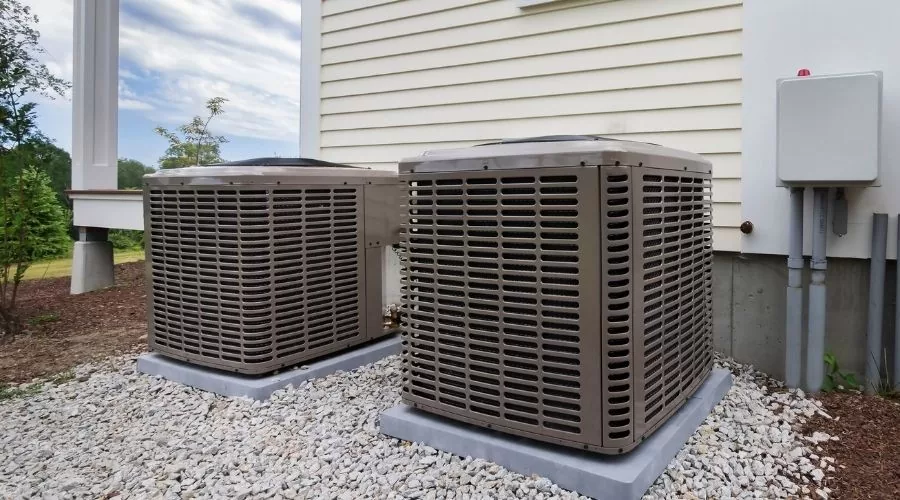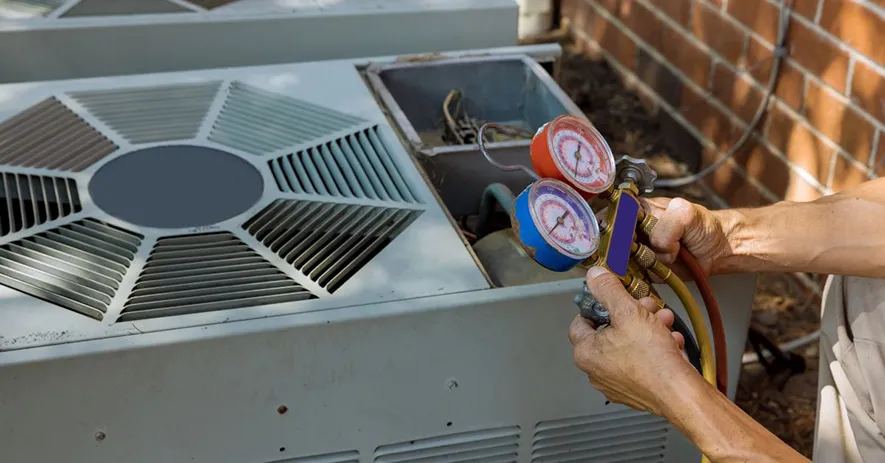It's a scorcher of a summer day, and you go to crank up the AC - but something's not quite right. The outdoor unit is humming away, but the fan isn't spinning like it should. Uh oh, you might be headed for an indoor inferno if you can't get it sorted! Before you start sweating bullets over costly repair bills, take a deep breath. There are actually several common reasons why your AC's outdoor fan might not be doing its whirling dervish routine.
From power snafus to capacitor conundrums and even a simple case of dust bunnies gone wild, we'll break down the likely culprits behind this nuisance. With some troubleshooting smarts, you might just beat the heat and get that twirling fan back in action! Let's start by understanding what the outdoor unit's fan does…

Understanding Your AC’s Outdoor Unit
When the summer temperatures start soaring, we all get reacquainted with our old friend the air conditioner. That indoor unit pumping out crisp, cooled air is a lifesaver, no doubt. But have you ever stopped to appreciate the other half of your home cooling system out back?
Your AC's outdoor condenser unit is the unsung hero pulling a lot of the weight. While not as visible as its indoor counterpart, this hardworking component deserves some time in the spotlight.
The Condenser Coil Core
At the heart of the outdoor unit lies the condenser coil - essentially a giant radiator filled with refrigerant lines. As this refrigerant circulates through the system, it absorbs heat and humidity from inside your home. By the time it reaches this coil, it's carrying a full payload of thermal energy it needs to expel outside.
The Exhaust Fan Lifeline
With all that heat built up in the coils, your AC needs a way to purge it from the system effectively. That's where the outdoor fan kicks into action. This fan's sole job is to draw large, steady volumes of outside air flowing across the finned surface of the condenser coils.
As that air passes over the coils, it allows the built-up heat from the refrigerant to dissipate outside, away from your home. Pretty neat, right? The fan's motor provides the power to keep those blades whirling consistently to maintain this crucial exhaust airflow.
The Cooling Cycle Continues
Once the fan expels the hot air, the refrigerant can cycle back indoors to continually absorb more heat and humidity. It's this constant loop that allows your AC to keep displacing hot air and replacing it with refreshing chilled air.
While the fan itself may seem small, it's utterly vital for your air conditioner to function properly. If this component can't spin and move enough air, you'll quickly feel the effects of that heat buildup. The whole cooling cycle gets thrown off.
So the next time you're enjoying some sweet AC relief, give a nod of thanks to that hardworking outdoor unit. It's playing a huge supporting role in the cooling process!
Common Reasons Why the Outdoor Fan Isn't Spinning
When your AC's outdoor unit is running but that fan isn't doing its whirling thing, it's likely stemming from one of several typical culprits. From electrical hangups to failing components, here are some of the most common reasons your outdoor fan might not be spinning...
Power Issues
What good is a fan if it has no juice to run in the first place? Power issues disrupting the electrical flow to the outdoor unit can certainly leave your fan dead in the water. A tripped circuit breaker or blown fuse somewhere along the electrical supply chain will cut off the fan motor's life source.
But it's not always that obvious - power problems can stem from other areas too. Loose or corroded wiring connections anywhere between the main service panel and the condenser unit itself can create resistance interrupting full voltage delivery. Heck, even a drained thermostat battery can keep the fan from ever getting the "kick on" signal in the first place.
Capacitor Problems
Even with power flowing freely to the outdoor unit, the fan motor still needs an extra electric kick to get that heavy-duty spin cycle going. That's where capacitors come into play as horsepower-boosting battery packs specifically for motors.
Most units use a run capacitor to provide a constant flow of current keeping the fan spinning once activated. But to initially overcome that stubborn inertia, some larger motors also rely on a separate start capacitor to supply an extra torque surge upon startup. When either capacitor starts degrading, the fan strains to rotate or simply fails to start.
Motor Issues
Of course, let's not overlook the star of the spinning show itself - the actual fan motor. These hardworking mechanical units can run into their own array of internal issues over years of constant operation and heat exposure.
Common failures like worn or seized bearings can cause the motor's inner components to grind noisily or lock up entirely, preventing any rotation. Motor windings and other electricals can burn out prematurely from overheating. And overall lack of lubrication allows increased friction that overtaxes the motor. An unwell motor equals a no-spin fan.
Thermostat & Control System Issues
Sometimes the fan itself could be in perfect health, but issues further up the chain of command are preventing it from ever being deployed properly. Your AC's brain center - the thermostat and control system - are what signal when and how the fan should operate based on cooling demands.
Bad thermostat wiring connections or depleted batteries can communicate faulty cooling needs. Control boards and relays can fail to energize the necessary fan activations. Electrical shorts anywhere in these systems can scramble operations entirely. When the "start" order never makes it through successfully, the fan stays in park.
So while a motionless outdoor fan might seem like a straightforward mechanical failure, the real root cause could be stemming from anywhere in the electrical control chain keeping everything powered and properly commanded. Hunting down the culprit takes some investigating!
Debris and Physical Obstructions
While we'd love for our outdoor units to operate within a pristine vacuum-sealed environment, the reality is they're exposed to the harsh great outdoors. That means all sorts of dirt, leaves, sticks and other organic debris can potentially wreak havoc.
It doesn't take much for these foreign objects to foul up the delicate fan blades and mechanisms that need to spin freely. A built-up wad of cottonwood fuzz or dry leaves blocking the fan's path is more than enough obstruction to gridlock those whirling blades. Overgrown shrubbery encroaching too close to the unit can also physically impede rotation.
Heck, even smaller objects like a baseball or frisbee carelessly tossed could bend or jam components, leaving that fan frozen in its tracks. The outdoors is an unpredictable place!
Frozen Coil
We tend to think of AC troubles striking during the blistering summer months. But Jack Frost can actually be a formidable foe too when temperatures plummet. If the outdoor unit's coils become encased in ice due to freezing conditions, it creates a skating rink scenario for that fan.
With the coil fins essentially frozen solid, the fan blades have no way to pull air through the dense ice blockade. The added weight from buildup can also severely strain the motor trying to turn those ice-coated blades. In extreme scenarios, the whole coil could resemble a solid ice cube, preventing any rotation whatsoever.
Frozen coils often trace back to other AC system problems like refrigerant leaks or frozen components indoors. But for the outdoor fan's sake, it means a no-spin situation until those icy conditions can thaw.
Age and Wear of the Unit
Like any hardworking machine, the constant grind of yearly operation ultimately takes a toll on HVAC equipment over time. With enough annual mileage, the outdoor unit's fan and all its components will start exhibiting signs of age and general wear.
Bearings grow increasingly sluggish as lubricants dry up. Fan blade spin grows increasingly imbalanced from warping or debris buildup. Electrical connections loosen and succumb to corrosion. Thermostats and control systems have more hiccups. Even the motor's windings can fatigue from heat stress.
At some point for any aging unit, these compounding issues increase the likelihood that the fan's mechanisms simply can't turn over as consistently or smoothly as it once could fresh off the assembly line. Decreased or stalled rotation becomes more probable.
Faulty Relay Switch
We've already covered some common failure points like capacitors that provide the fan motor's all-important electric kick. But those same power delivery channels rely on a crucial control relay to properly activate in the first place.
This electrical relay acts as the gatekeeper, switching the power supply on and off to components like the outdoor fan motor based on prompted cooling needs from the thermostat. When that relay mechanism fails due to age or electrical faults, it can leave the fan hanging without its "spin" command ever being triggered.
Concealed in the guts of the unit's control paneling, these compact switches are prone to problems like stuck contacts, overheating, and circuit board corruptions that prevent them channeling the full electrical flow. An uncooperative relay means the fan never gets the juice to operate, simple as that.
Incorrect Installation or Setup
They say the road to air conditioning hell is paved with good intentions... and shoddy installation jobs. If your outdoor unit wasn't properly installed and set up to begin with, operating issues are just waiting to rear their ugly head down the line.
Maybe the condenser pad wasn't leveled correctly, leading to excessive vibrations that can prematurely loosen components over time. Or the specified clearance space around the unit wasn't followed, restricting adequate airflow right out of the gate. Electrical lines could have been improperly sized or connected.
Heck, there's even a chance the wrong size or style of fan blade was installed that's incompatible for that specific unit's tonnage and airflow needs. When professionals cut corners or make mistakes during that crucial setup phase, fans can fail to spin at full rotational speeds pretty quickly.
Defective Fan Blade
Speaking of those all-important spinning blades, sometimes a manufacturer's defect can throw a wrench into operations too. While fairly rare, there are instances where newly installed fan blades from the factory suffer from subpar materials or production flaws.
Improperly balanced blades with uneven weight distribution can wobble erratically instead of achieving that smooth, cyclical spin. Hairline cracks or brittleness in the blade structure can cause major failures once the speeds pick up. Design defects affecting aerodynamics and airflow can overtax the motor.
If you unfortunately received a lemon straight out of the box, that brand new outdoor fan might be dead on arrival until those faulty blades get replaced.
Environmental Factors
We've already touched on some environmental exposures like debris, vegetation growth, and seasonal ice hazards. But other localized climate factors like high heat, humidity, salt air, or even critter infestations can all accelerate wear on outdoor units too.
Excessive heat radiating off of rooftops can overwork components year after year. High humidity and coastal salt air is extremely corrosive on metal surfaces. Rodents or birds constantly nesting near the fan intake can lead to all sorts of obstructions.
While modern condensers are built tough, extremely harsh environmental conditions in certain geographic regions can definitely take their toll faster on longevity and reliability. Surprise summer sandstorms, anyone?
Safety Switches and Controls
In an effort to prevent larger system emergencies, outdoor AC units build in various safety switches and controls that can purposefully shut down the fan under certain detected fault conditions. Seeing that lifeless fan might just be a fail-safe kicking in.
Components like pressure switches, overload relays, and temperature limits all act as circuit breakers monitoring for scenarios that could pose fire risks or physical dangers if operations continued. For instance, if extreme high or low refrigerant pressure triggers the safety switch, hitting that kill switch and cutting off the fan is a preventative measure.
So while an idle outdoor fan looks like a cut-and-dry failure on the surface, it could actually represent a key protective feature doing its job by shutting systems down temporarily. Smart safety...frustrating outcome when you just want some cool air!
From electrical foul-ups to mechanical breakdowns and other environmental exposures, there's unfortunately no shortage of potential culprits behind a motionless outdoor AC fan. Pinpointing the specific issue is the first step before determining the fix!
Troubleshooting That Stalled Outdoor Fan
So you've got an AC outdoor fan that stubbornly refuses to spin, but no idea what the culprit could be yet. Before you resign yourself to professional repair calls, there are some basic troubleshooting steps worth trying yourself first. You might just solve the mystery!
Start With the Simple Stuff
Whenever dealing with electrical equipment like air conditioners, always begin any DIY work by completely shutting off all power sources for safety. Unplug the condenser unit's connection from the house, and flip the circuit breaker controlling that power supply.
With everything powered down, your first move is to give that whole outdoor unit a thorough visual inspection. Clear away any noticeable debris, vegetation overgrowth, or objects that could be physically obstructing or hitting the fan blades and motor housing. Use a set of protective gloves and brush away anything stuck in there.
Next, check all the fan blades themselves. Any that appear cracked, bent, or extremely unbalanced compared to others could be the drag behind any stalling or struggling to rotate properly. Ensure the whole blade assembly can spin freely by manually rotating it once the area is clear.
Electrical Inspection
Now it's time to start tracing the actual electrical supply line to ensure your fan motor is receiving sufficient power. Using a multimeter or voltage sensor, confirm that the condenser unit's incoming breaker box connection and internal wiring is properly delivering 220-240 volt power as expected.
If passing voltage looks good up to the unit, start inspecting where the fan itself connects. Look for any frayed, loose, or burned wiring terminations at the motor housing or capacitors that could be interrupting electricity flow. Test those capacitor terminals too - if they've stopped providing the proper microfarad ratings, that's often an easy capacitor replacement fix.
Check Control Sequencing
With the outdoor unit's main power sources verified, shift your focus to the control systems responsible for actually activating that fan at the right times and sequences. Pop off the control panel covers using instructions to expose components like fan relays and circuit boards within.
Using a multimeter, confirm those control boards are receiving and correctly deploying the low-voltage thermostat signals intended to kick the entire fan/compressor cycle on and off as temperatures dictate. Look for any scorched components or loose wiring connections disrupting proper relay operations too.
Listen & Sniff
If voltage testing hasn't revealed any major power interruptions yet, it's time to rely on some of your other trusted home repair senses - listening and smelling. Restart the AC system while keeping a safe distance, then use your ears for any auditory clues.
An extremely loud buzzing or growling groan might indicate a bearings issue or other major mechanical bind within the actual fan motor housing. The distinct smell of burnt electrical insulation or ozone can signify fried components like windings in need of professional replacement.
When All Else Fails
For outdoor fan issues involving anything more complicated than cleaning, routine maintenance, or basic repairs like capacitor replacements, it's best to resign the job to certified HVAC professionals at this stage. They have the proper equipment, training, and safety expertise.
Professional-grade electrical testing tools can fully evaluate control boards, motors, and refrigerant system operations that could be behind any fan failures. Experienced techs can also dismount and carefully inspect motors internally to repair components like bent shafts or bearings that you can't easily access.
Don't risk personal injury or accidentally causing further damage through inexperienced DIY efforts. Bringing in a trained set of eyes is sometimes the smartest and most cost-effective approach for more complex outdoor fan diagnosis and repair needs.
When to Call in the Pros for Outdoor Fan Repair
As handy as some of those DIY troubleshooting tips may be, there inevitably comes a point when it's wisest to resign that stubborn outdoor fan issue to the professionals. Experienced HVAC techs have specialized tools, training and know-how to properly diagnose and repair problems you can't easily handle yourself.
While minor tasks like clearing debris or replacing capacitors might be fair game for weekend warriors, any fan failures involving major electrical or mechanical components are better left to the experts who can safely tackle the job without unnecessary risks or expenses.
When It's Time to Phone the Pros
There are several scenarios where picking up the phone to schedule an AC repair appointment is your best next move:
Complete Motor/Fan Blade Replacements
If troubleshooting reveals that the outdoor fan motor itself is seized, burned out, or improperly spinning due to bearing damage or other internal faults, full replacement installations are no DIY task. HVAC techs have the proper equipment and expertise to properly dismount old motors, choose and wire up appropriate replacements, and ensure everything from blade alignment to electrical terminations are perfect.
Refrigerant System Issues
Any problems revolving around your AC's refrigerant lines, coils, pressure levels or compressor could be indirectly behind that outdoor fan conking out prematurely. Refrigerant leaks, clogs and contamination issues require an EPA-certified professional's oversight for safe handling. Those fan symptoms might just be the tip of the iceberg.
Electrical/Control Board Faults
While you can check for some obvious wiring issues, any significant problems with components like circuit boards, fan relays, thermostat foul-ups and transformer failures are pretty far beyond the average homeowner's capabilities and test equipment. One misdiagnosed electrical issue could lead to serious damage or dangers.
System Sizing/Installation Errors
If an outdoor fan replacement seems to only be a short-term fix before failure happens all over again, there could be an underlying mismatch or installation issue requiring a second expert opinion. Maybe your unit was undersized versus proper cooling load calculations in the first place. Or it's installed in a poor location restricting airflow. An experienced pro can identify root causes like these that your average DIYer would easily overlook.
Safety Hazard Concerns
Let's be honest - HVAC equipment involves high voltages, powerful spinning components, heavy machinery and other potential safety hazards if mishandled incorrectly. Any concerns about electrical shocks, burnt wiring risks, refrigerant leaks/toxicity or other operations that could endanger your household mean walking away and calling a certified technician immediately. Your personal safety and liability always come first.
Annual Clean & Tune-Up Services
Of course, you don't have to wait for fan failures as an excuse to get some professional assistance either. One of the best ways to prevent outdoor unit issues in the first place is through annual preseason clean and tune services by your trusted HVAC crew.
These maintenance visits allow technicians to thoroughly inspect all components - from checking fan blade balance and motor amperage, to greasing bearing ports and tightening electrical connections. Any worn parts get replaced and refrigerant levels checked to ensure your system runs optimally and efficiently for maximum cooling power (and lower utility costs) all summer long.
Between diagnosed repairs and preventative maintenance, keeping an open line with certified HVAC pros is vital for extending your outdoor AC fan's lifespan while minimizing needless expense from unexpected breakdowns. Their expertise keeps everything spinning smoothly!
Prevent Future Outdoor Fan Headaches
An ounce of prevention is worth a pound of cure, as the saying goes. And when it comes to your air conditioning system's outdoor fan components, being proactive about maintenance and care can go a long way toward avoiding costlier repairs down the line.
While you can't control every potential failure, there are some smart preventive measures worth adding to your seasonal HVAC checklist:
Keep It Clean
One of the easiest ways to prevent debris and overgrowth from gumming up your outdoor fan's works? Prioritize cleanliness around that condensing unit. Use a soft-bristle brush to regularly wipe off any accumulating dirt, leaves, grass clippings or cotton fluff before it can take root.
While you're at it, ensure any nearby shrubbery, plants or objects maintain a safe buffer space of 2-3 feet away from the unit to allow proper airflow and access. Trim back any encroaching growth. Creating that clear perimeter makes future clean-up and inspection much easier.
Listen for Warning Signs
Your ears can be invaluable diagnostic tools when it comes to catching minor outdoor fan issues before they escalate into bigger problems. During routine system startups, pause for a moment to listen to the fan's operating noises.
Any screeching, grinding or unusual rattling could signal deteriorating fan motor bearings in need of lubrication or replacement. Excessive vibrations might mean the fan is unbalanced and due for blade inspection. Don't ignore sounds out of the ordinary - they could be cries for help!
Follow a Maintenance Schedule
Even with annual professional tune-ups, outdoor units still require some routine homeowner maintenance too. Creating a seasonal checklist can ensure no simple preventive tasks fall through the cracks.
Tasks like clearing drainage channels, checking fan blade balance, hosing off the coil fins and changing return air filters all increase efficiency and longevity for that outdoor fan motor. Following manufacturer-recommended maintenance schedules keeps everything running smoothly.
Provide Shading/Protection
While made to withstand the outdoor elements, your condensing units can still benefit from a bit of shaded protection from the harshest conditions. If possible, install a pergola, awning or shrub windbreak to provide partial shading that cuts down on radiant heating loads.
For coastal regions, you might even consider a breathable mesh cover that allows airflow but creates a barrier against corrosive salty air and sea mist. The less extraordinarily intense weather exposure those outdoor components deal with, the longer they'll operate at peak performance levels.
With some basic preventive practices under your belt, you'll go a long way toward avoiding surprise outdoor fan failures that can cut your cooling comfort short. Just a little elbow grease keeps your HVAC system and interior temps chilled!
Keeping That Cool Air Flowing
There's nothing worse than an outdoor AC fan that quits on you mid-summer. When those blades grind to a halt, it's only a matter of time before your cooling comfort gets left sweltering.
From electrical mishaps to mechanical breakdowns, we've walked through the many potential culprits that can leave your condenser unit's fan stuck in stall mode. While some causes might be simple DIY fixes, others require the skilled hand of a professional HVAC technician to properly diagnose and repair.
The good news? With a century of experience boosting Portland-area homeowners' chill, the family experts at Sunset Heating & Cooling have seen and solved every possible outdoor fan failure. Their team remains on call all summer long to quickly restore your cooling airflow.
So if your AC's outdoor fan is giving you issues, stay frosty and give Sunset a call at (503) 500-5866. They'll make sure your home's breathable air keeps spinning smoothly!






